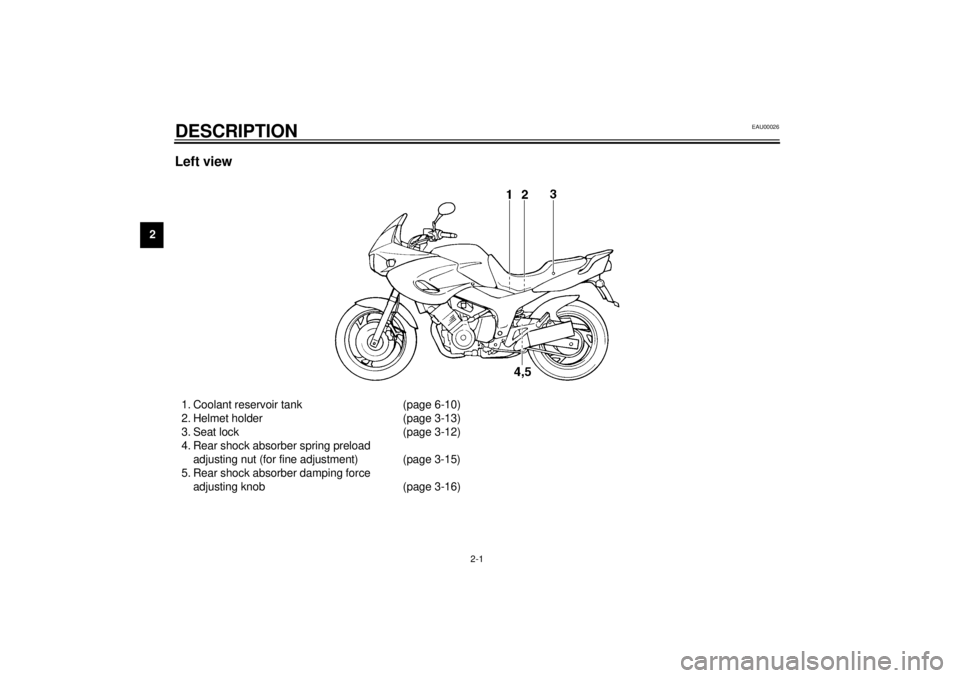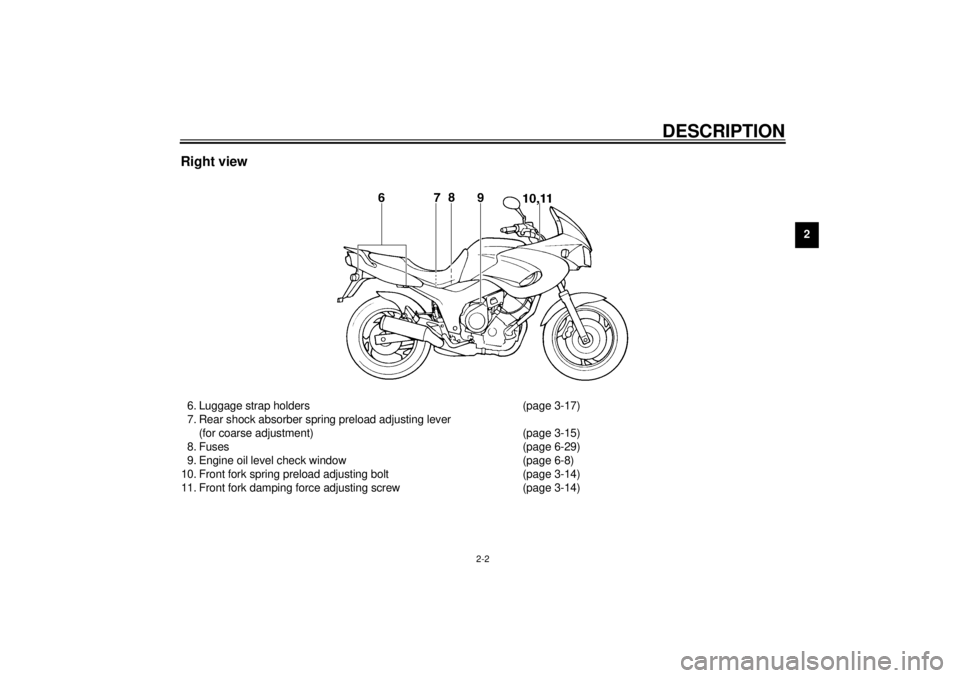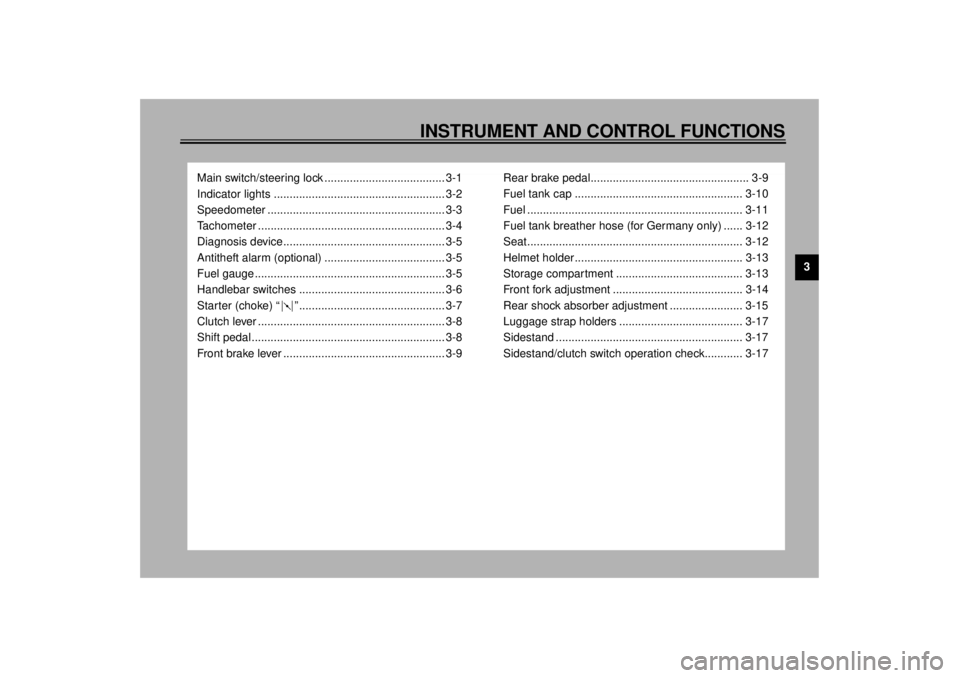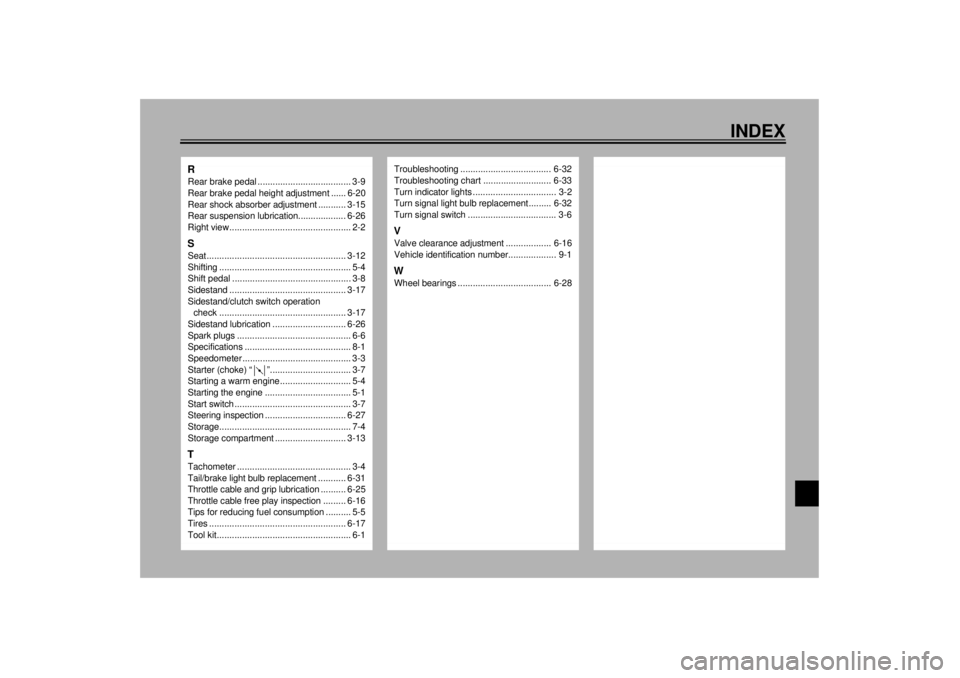ABS YAMAHA TDM 850 2000 Owners Manual
[x] Cancel search | Manufacturer: YAMAHA, Model Year: 2000, Model line: TDM 850, Model: YAMAHA TDM 850 2000Pages: 99, PDF Size: 10.69 MB
Page 11 of 99

2-1
2
EAU00026
2-DESCRIPTIONLeft view1. Coolant reservoir tank (page 6-10)
2. Helmet holder (page 3-13)
3. Seat lock (page 3-12)
4. Rear shock absorber spring preload
adjusting nut (for fine adjustment) (page 3-15)
5. Rear shock absorber damping force
adjusting knob (page 3-16)
E_4tx_Description.fm Page 1 Saturday, October 16, 1999 9:36 AM
Page 12 of 99

DESCRIPTION
2-2
2
Right view6. Luggage strap holders (page 3-17)
7. Rear shock absorber spring preload adjusting lever
(for coarse adjustment) (page 3-15)
8. Fuses (page 6-29)
9. Engine oil level check window (page 6-8)
10. Front fork spring preload adjusting bolt (page 3-14)
11. Front fork damping force adjusting screw (page 3-14)
E_4tx_Description.fm Page 2 Saturday, October 16, 1999 9:36 AM
Page 14 of 99

3
INSTRUMENT AND CONTROL FUNCTIONS
Main switch/steering lock ...................................... 3-1
Indicator lights ...................................................... 3-2
Speedometer ........................................................ 3-3
Tachometer ........................................................... 3-4
Diagnosis device................................................... 3-5
Antitheft alarm (optional) ...................................... 3-5
Fuel gauge ............................................................ 3-5
Handlebar switches .............................................. 3-6
Starter (choke) “ ” .............................................. 3-7
Clutch lever ........................................................... 3-8
Shift pedal ............................................................. 3-8
Front brake lever ................................................... 3-9Rear brake pedal.................................................. 3-9
Fuel tank cap ..................................................... 3-10
Fuel .................................................................... 3-11
Fuel tank breather hose (for Germany only) ...... 3-12
Seat.................................................................... 3-12
Helmet holder..................................................... 3-13
Storage compartment ........................................ 3-13
Front fork adjustment ......................................... 3-14
Rear shock absorber adjustment ....................... 3-15
Luggage strap holders ....................................... 3-17
Sidestand ........................................................... 3-17
Sidestand/clutch switch operation check............ 3-17
E_4tx_FunctionsTOC.fm Page 1 Saturday, October 16, 1999 9:36 AM
Page 29 of 99

INSTRUMENT AND CONTROL FUNCTIONS
3-15
3
EAU01768*
Rear shock absorber
adjustmentThis shock absorber is equipped with
two spring preload adjusters and one
damping force adjuster.
Spring preload
Coarse adjustment (top)Use the special tool in the owner’s tool
kit to turn the lever to “S” when riding
solo and to “H” when riding with a pas-
senger.Fine adjustment (bottom)
Proceed as follows to suit road condi-
tions and the rider’s preference.
1. Loosen the locknut.
2. Turn the adjusting nut in direction
a
to increase spring preload and in di-
rection
b to decrease spring pre-
load.
1. Adjusting lever
1. Locknut
2. Adjusting nut
a. Distance “A”
Spring preload:
Minimum (soft):
Distance “A” = 59 mm
Standard:
Distance “A” = 61 mm
Maximum (hard):
Distance “A” = 63 mm
E_4tx_Functions.fm Page 15 Saturday, October 16, 1999 9:36 AM
Page 30 of 99

INSTRUMENT AND CONTROL FUNCTIONS
3-16
3 3. Tighten the locknut to the speci-
fied torque.
EC000018
CAUTION:@ Always tighten the locknut against
the spring adjusting nut and tighten
the locknut to the specified torque. @
Damping force adjustment
Turn the adjusting knob in direction
a
to increase damping force and in direc-
tion
b to decrease damping force.CI-29E
EC000015CAUTION:@ Never attempt to turn an adjuster
beyond the maximum or minimum
setting. @
EAU00315
WARNING
@ This shock absorber contains high-
ly pressurized nitrogen gas. Read
and understand the following infor-
mation before handling the shock
absorber. The manufacturer cannot
be held responsible for property
damage or personal injury that may
result from improper handling.l
Do not tamper with or attempt to
open the cylinder assembly.
l
Do not subject the shock ab-
sorber to an open flame or other
high heat source. This may
cause the unit to explode due to
excessive gas pressure.
l
Do not deform or damage the
cylinder in any way. Cylinder
damage will result in poor
damping performance.
l
Take your shock absorber to a
Yamaha dealer for any service.
@
Tightening torque:
Locknut:
70 Nm (7.0 m·kg)
1. Adjusting knobMinimum (soft) 20 clicks out*
Standard 10 clicks out*
Maximum (hard) 0 click out*
* From the fully turned-in position
E_4tx_Functions.fm Page 16 Saturday, October 16, 1999 9:36 AM
Page 49 of 99

PERIODIC MAINTENANCE AND MINOR REPAIR
6-3
6
12
*Swingarm• Check swingarm pivoting point for play.
• Correct if necessary.
• Lubricate with molybdenum disulfide grease every 24,000 km
or 24 months (whichever comes first).ÖÖ
13 Drive chain• Check chain slack.
• Adjust if necessary. Make sure that the rear wheel is properly aligned.
• Clean and lubricate. Every 500 km and after washing the
motorcycle or riding in the rain
14*Steering bearings• Check bearing play and steering for roughness.
• Correct accordingly.
• Lubricate with lithium soap base grease every 24,000 km
or 24 months (whichever comes first).ÖÖ
15*Chassis fasteners• Make sure that all nuts, bolts and screws are properly tightened.
• Tighten if necessary.ÖÖ
16 Sidestand• Check operation.
• Lubricate and repair if necessary.ÖÖ
17*Sidestand switch• Check operation.
• Replace if necessary.ÖÖÖ
18*Front fork• Check operation and for oil leakage.
• Correct accordingly.ÖÖ
19*Rear shock absorber
assembly• Check operation and shock absorber for oil leakage.
• Replace shock absorber assembly if necessary. ÖÖ
20*Rear shock absorber
assembly pivoting points• Check operation.
• Lubricate with molybdenum disulfide grease every 24,000 km
or 24 months (whichever comes first).ÖÖ
21*Carburetors• Check engine idling speed, synchronization and starter operation.
• Adjust if necessary.ÖÖÖ
22 Engine oil• Check oil level and vehicle for oil leakage.
• Correct if necessary.
• Change. (Warm engine before draining.)ÖÖÖ
23 Engine oil filter element
• Replace.ÖÖ NO. ITEM CHECKS AND MAINTENANCE JOBSINITIAL
(1,000 km)EVERY
6,000 km
or
6 months
(whichever
comes first)12,000 km
or
12 months
(whichever
comes first)
E_4tx_Periodic.fm Page 3 Saturday, October 16, 1999 9:37 AM
Page 85 of 99

MOTORCYCLE CARE AND STORAGE
7-3
71. Clean your motorcycle with cold
water and soap after the engine
has cooled down.
ECA00012
CAUTION:@ Do not use warm water since it in-
creases the corrosive action of the
salt. @2. Be sure to apply a corrosion pro-
tection spray on all (even chrome-
and nickel-plated) metal surfaces
to prevent corrosion.After cleaning
1. Dry the motorcycle with a chamois
or an absorbing cloth.
2. Immediately dry the drive chain
and lubricate it to prevent it from
rusting.
3. Use a chrome polish to shine
chrome, aluminum and stainless-
steel parts, including the exhaust
system. (Even the thermally in-
duced discoloring of stainless-
steel exhaust systems can be re-
moved through polishing.)
4. To prevent corrosion, it is recom-
mended to apply a corrosion pro-
tection spray on all (even chrome-
and nickel-plated) metal surfaces.
5. Use spray oil as a universal clean-
er to remove any remaining dirt.
6. Touch up minor paint damage
caused by stones, etc.
7. Wax all painted surfaces.
8. Let the motorcycle dry completely
before storing it or covering it.
EWA00001
WARNING
@ Make sure that there is no oil or wax
on the brakes and tires. If neces-
sary, clean the brake discs and lin-
ings with a regular brake disc
cleaner or acetone, and wash the
tires with warm water and mild soap.
Then, carefully test the motorcycle
for its braking performance and cor-
nering behavior. @
E_4tx_Cleaning.fm Page 3 Saturday, October 16, 1999 9:38 AM
Page 91 of 99

SPECIFICATIONS
8-3
8
Maximum load* 203 kg
Air pressure (cold tire)
Up to 90 kg load*
Front 225 kPa (2.25 kg/cm
2, 2.25 bar)
Rear 275 kPa (2.75 kg/cm2, 2.75 bar)
90 kg load ~ maximum
load*
Front 225 kPa (2.25 kg/cm2, 2.25 bar)
Rear 275 kPa (2.75 kg/cm2, 2.75 bar)
High speed riding
Front 225 kPa (2.25 kg/cm2, 2.25 bar)
Rear 275 kPa (2.75 kg/cm2, 2.75 bar)
* Load is total weight of cargo, rider, passenger and accessories.
Wheels
Front
Ty p e C a s t
Size 18 ´ MT3.00
Rear
Ty p e C a s t
Size 17 ´ MT4.00
Brakes
Front
Type Dual disc brake
Operation Right hand operation
Fluid DOT 4Rear
Type Single disc brake
Operation Right foot operation
Fluid DOT 4
Suspension
Front
Ty p e Te l e s c o p i c f o r k
Rear
Type Swingarm
Shock absorber
Front Coil spring / oil damper
Rear Coil spring / gas-oil damper
Wheel travel
Front 149 mm
Rear 144 mm
Electrical system
Ignition system T.C.I. (digital)
Charging system
Type A.C. magneto
Standard output 14 V, 23.5 A @ 5,000 r/min
Battery
Type GT12B-4
Voltage, capacity 12 V, 10 AH
Headlight typeQuartz bulb (halogen)
E_4tx_Spec.fm Page 3 Saturday, October 16, 1999 9:38 AM
Page 98 of 99

INDEX
RRear brake pedal ..................................... 3-9
Rear brake pedal height adjustment ...... 6-20
Rear shock absorber adjustment ........... 3-15
Rear suspension lubrication................... 6-26
Right view................................................ 2-2SSeat....................................................... 3-12
Shifting .................................................... 5-4
Shift pedal ............................................... 3-8
Sidestand .............................................. 3-17
Sidestand/clutch switch operation
check .................................................. 3-17
Sidestand lubrication ............................. 6-26
Spark plugs ............................................. 6-6
Specifications .......................................... 8-1
Speedometer ........................................... 3-3
Starter (choke) “ ”................................ 3-7
Starting a warm engine ............................ 5-4
Starting the engine .................................. 5-1
Start switch .............................................. 3-7
Steering inspection ................................ 6-27
Storage.................................................... 7-4
Storage compartment ............................ 3-13TTachometer ............................................. 3-4
Tail/brake light bulb replacement ........... 6-31
Throttle cable and grip lubrication .......... 6-25
Throttle cable free play inspection ......... 6-16
Tips for reducing fuel consumption .......... 5-5
Tires ...................................................... 6-17
Tool kit..................................................... 6-1
Troubleshooting .................................... 6-32
Troubleshooting chart ........................... 6-33
Turn indicator lights ................................. 3-2
Turn signal light bulb replacement ......... 6-32
Turn signal switch ................................... 3-6VValve clearance adjustment .................. 6-16
Vehicle identification number................... 9-1WWheel bearings ..................................... 6-28
E_4txIX.fm Page 2 Saturday, October 16, 1999 9:38 AM